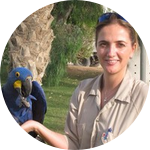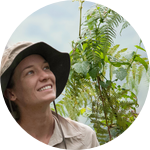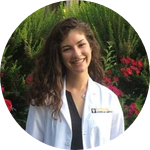About This Project
Elephant endotheliotropic herpes virus hemorrhagic disease (EEHV-HD) is the leading cause of death of young Asian elephants in North America and Europe, and suspected to occur in Myanmar. We will validate EEHV testing methods for feces and chewed plants, samples that can be easily collected, to enable a longitudinal study of EEHV epidemiology in captive and wild elephant herds in Myanmar. The ultimate goal is to identify management-related mitigation strategies for this devastating disease.
Ask the Scientists
Join The DiscussionWhat is the context of this research?
Elephant endotheliotropic herpes virus hemorrhagic disease (EEHV-HD) is the leading cause of death of young Asian elephants in North America and Europe, and suspected to cause disease in range countries, particularly Myanmar. EEHV can cause a rapidly fatal hemorrhagic disease, which has little treatment success. Understanding EEHV is incredibly challenging, as the virus can only presently be detected through blood and trunk secretions, which is impossible in wild elephants and many working elephant herds in Asia. Non-invasive sample collection methods would make it possible to study the epidemiology of EEHV in range countries. This will allow us to understand risk factors for the disease and identify practical mitigation strategies.
What is the significance of this project?
EEHV-HD is the most important infectious cause of mortality in Asian elephants. Non-invasive testing methods will facilitate the study of EEHV in elephants in Myanmar, home to the second largest number of both working and wild elephants in the world, and an invaluable resource for understanding EEHV disease epidemiology. Understanding the transmission dynamics of this disease is critical. It will allow conservation resources to be allocated towards mitigating environmental and/or husbandry related contributions to the disease, and reduce the impact of EEHV on Myanmar elephants. Elephants are an integral part of human livelihoods, society and commerce in Myanmar, making EEHV significant for both people and elephants throughout the region.
What are the goals of the project?
The goal of this project is to validate the use of two sample types, feces and discarded chewed plants, for the detection of EEHV shedding in captive and free-ranging Asian elephant herds. We will collect paired non-invasive and traditional sample types from elephants at the Houston Zoo over the course of 6 weeks. These samples will be tested for EEHV using qPCR, and results used to optimize a a non-invasive sample collection protocol for use in the field. Our methods will enable future planned epidemiologic studies on the shedding patterns and spectrum of EEHV-HD in Myanmar and other Asian elephant range countries. This project will also support the training of a second- year veterinary student on laboratory techniques and epidemiologic analysis skills.
Budget
We are seeking funds to cover the costs of laboratory reagents for our pilot study with elephants at the Houston Zoo and a trial study in wild and captive herds in Myanmar. This project is part of a larger ongoing study investigating zoonotic viral sharing between elephant mahouts and wildlife in elephant logging camps in Myanmar. Costs for travel expenses and sample collection in Myanmar are leveraged through other sources of funds already acquired for this larger study.
We have added a stretch goal, which will cover the expenses of ongoing sample collection with the Houston Zoo elephant herd, since the birth of their newest baby elephant. This goal will allow us to hopefully capture additional EEHV shedding time points for analysis.
Endorsed by
 Project Timeline
Project Timeline
Sample collection from elephants at the Houston Zoo
Diagnostics for EEHV at the University of California, Davis
Data analysis and validation of non-invasive techniques
Field testing of optimal sample protocol techniques in Myanmar
Development of standardized non-invasive sample collection protocols for EEHV and distribution through the Asian Elephant EEHV working group
Development of initial database for longitudinal study of EEHV epidemiology in Myanmar
Aug 21, 2018
Project Launched
Aug 31, 2018
Collection of trunk wash, blood, oral swab, fecal and chewed plant samples from Houston Zoo elephants
Sep 30, 2018
Diagnostics for EEHV at the University of California, Davis
Oct 31, 2018
Data analysis and validation of non-invasive techniques
Nov 30, 2018
Field testing of optimal sample protocol techniques in Myanmar
Meet the Team
Affiliates
Tierra Smiley Evans
I am a veterinary epidemiologist at the Karen C. Drayer Wildlife Health Center (WHC) at the University of California, Davis. My research is focused on novel methods for non-invasive wildlife health diagnostics. I have developed several techniques for non-invasive viral surveillance in wildlife including a technique to recover herpesviruses from discarded chewed plants. I molecularly described the first beta and gamma herpesviruses detected in mountain gorillas and used discarded chewed plants to show the epidemiologic similarities between mountain gorilla and human herpesvirus transmission. I have experience leading wildlife health projects in Rwanda, Uganda, Nepal and Myanmar and now lead the WHC’s collaborative project with the government of Myanmar and the National Institutes of Health, investigating viral sharing between humans and wildlife in elephant logging camps in Myanmar.
Alison Jeffrey
I am a third-year veterinary student at the University of California, Davis, School of Veterinary Medicine. My professional interests include wildlife, zoo, and conservation medicine. My long-term career goal is to contribute to the resolution of conservation issues surrounding threatened species both domestically and internationally by incorporating clinical work and wildlife research projects into a veterinary career. I am excited to be starting this career path by contributing to the study of elephant endotheliotropic herpesvirus in Asian elephants.
Kirsten Gilardi
I am a wildlife veterinarian and Co-Director of the Karen C. Drayer Wildlife Health Center (WHC) and a Health Sciences Clinical Professor in the Department of Medicine & Epidemiology at the University of California, Davis School of Veterinary Medicine. I earned my DVM at UC Davis in 1993, and my dream was that somehow I would figure out how to apply my veterinary training to help conserve free-ranging wildlife. Right after veterinary school, I did a 3-year residency in Medical Primatology at the California National Primate Research Center (Davis, CA), and after that joined the staff of the WHC in 1998. In 2001, I became board-certified by the American College of Zoological Medicine, and was honored to receive the AAZV’s Emil P. Dolensek Award in 2015. I am a past President of the American Association of Wildlife Veterinarians.
Christine Molter
I am a staff veterinarian at the Houston Zoo in Houston, Texas and coordinate the zoo's EEHV collaborations. The Houston Zoo is a leader in the global movement to save wildlife and is dedicated to EEHV research, clinical case management, and international working group support. I earned my DVM at the University of Wisconsin in 2011 and completed a residency in Zoological Medicine through the University of California, Davis and San Diego Zoo Global in 2015. I became a Diplomate of the American College of Zoological Medicine in 2016.
Additional Information
Asian elephants serve as working or “draft” animals in many countries around the world, and are used in the logging industry throughout Myanmar’s famed teak forests. These elephants were originally captured from the wild, and the success of their breeding in captivity now influences the sustainability of both captive and wild herds in Myanmar. As logging is ceasing in some regions of Myanmar, surplus captive elephants are being considered for potential reintroduction to the wild. The development of non-invasive testing capacities for EEHV and a better understanding of the EEHV strains circulating in captive and wild herds is essential to making informed decisions regarding reintroduction.
Project Backers
- 74Backers
- 144%Funded
- $6,021Total Donations
- $67.41Average Donation




